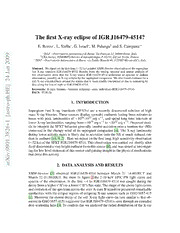Table Of ContentThe first X-ray eclipse of IGR J16479-4514?
E. Bozzo∗, L. Stella∗, G. Israel∗, M. Falanga† and S. Campana∗∗
9 ∗INAF-OsservatorioAstronomicodiRoma,ViaFrascati33,00044Rome,Italy.
0 †CEASaclay,DSM/IRFU/Serviced’Astrophysique,F-91191,GifsurYvette,France.
0 ∗∗INAF-OsservatorioAstronomicodiBrera,viaEmilioBianchi46,I-23807Merate(LC),Italy.
2
n Abstract. Wereportonthefirstlong(∼32ks)pointedXMM-Newtonobservationofthesupergiant
a
fast X-ray transient IGRJ16479-4514. Results from the timing, spectral and spatial analysis of
J
this observation show that the X-ray source IGRJ16479-4514 underwent an episode of sudden
4
obscuration,possiblyanX-rayeclipsebythesupergiantcompanion.Wealsofoundevidencefora
2
softX-rayextendedhaloaroundthesourcethatismostreadilyinterpretedasduetoscatteringby
dustalongthelineofsighttoIGRJ16479-4514.
]
E
Keywords: X-rays:binaries-binaries:eclipsing-stars:individual(IGRJ16479-4514)
H
PACS: 97.80.Jp
.
h
p
- 1. INTRODUCTION
o
r
t Supergiant Fast X-ray transients (SFXTs) are a recently discovered subclass of high
s
a mass X-ray binaries. These sources display sporadic outbursts lasting from minutes to
[
hours with peak luminosities of ∼1036-1037 erg s−1, and spend long time intervals at
1 lowerX-rayluminosities,rangingfrom∼1034 ergs−1 to∼1032 ergs−1.Proposedmod-
v
6 els to interpret the SFXT behavior generally involve accretion onto a neutron star (NS)
2 immersed in the clumpy wind of its supergiant companion [4]. The X-ray luminosity
8
during lower activity states is likely due to accretion onto the NS at much reduced rate
3
. thanin outburst[10, 9, 2] . Herewereport on thefirst long,highsensitivityobservation
1
0 (∼32 ks) of the SFXT IGRJ16479-4514. This observation was carried out shortly after
9 Swiftdiscoveredaverybrightoutburstfromthissource[8],andwasaimedatinvestigat-
0
ingthelowlevelemissionofthissourceandgaininginsightinthephysicalmechanisms
:
v thatdrivethisactivity.
i
X
r
a 2. DATA ANALYSIS AND RESULTS
XMM-Newton [5] observed IGRJ16479-4514 between March 21 14:40:00UT and
March 22 01:30:00UT. We show In figure 1 the 2-10 keV EPIC-PN light curve and
spectra of the observation. In the first ∼4 ks IGRJ16479-4514 was caught during the
decayfromahigher(“A”)toalower(“B”)fluxstate.Theshapeoftheabovelightcurves
andevolutionofthespectrumacrossthestateA-stateBtransitionpresentedremarkable
similarities with the eclipse ingress of eclipsing X-ray sources such as OAO1657-415
[1]. Moreover the slower decay of the soft X-ray light curve (in turn similar to that ob-
served in OAO1657-415)suggestedthat IGRJ16479-4514is seen through an extended
dust-scatteringhalo[3]. To confirm thisweanalysedtheradialdistributionoftheX-ray
IGR J16479−4514 XMM−Newton Epic−PN IGR J16479−4514 XMM−Newton Epic−PN
A 2−5 keV B
Cts/s (2−10 keV) 0.51 Cts/sCts/s 0.050.10.150.51 5−10 keV normalized counts s keV−1−1 0.010.1 A (ingress) B (mid−eclipse)
4000 T60im00e (s) 8000 104 DcS 2(A) −202
5000 104 1.5×104Time (s2)×104 2.5×104 3×104 DcS 2(B) −202 3 Energy (ke5V) 10
FIGURE 1. Left panel: EPIC-PN light curve of IGRJ16479-4514 in the 2-10 keV band.
The bin time is 100 s and the start time is March 21 16:42:42UT. Right panel: 2-
10 keV spectra extracted from intervals A and B. The best fit models and the resid-
uals from these fits are also shown. The best fit parameters for state A (c 2/d.o.f. =
20.4/26) are: NH,a =351−813×1022 cm−2, NH,b =9−69×1022 cm−2, Ia =1.8−0.40.3×10−3, Ib =58−4×10−3,
E =6.530.06 keV, I =53 ×10−5, EW =0.15 keV. The measured X-ray flux in this state is
ln1 −0.07 ln1 −3 ln1
F2−10keV=10−11 erg/cm2/s,correspondingtoLX=2.9×1034 erg/s[thesourcedistanceis4.9kpc;6].For
the B state (c 2/d.o.f. =36.5/33) we found: NH,a =542−625×1022 cm−2, Ia =1.1−0.50.4×10−4, Ib =82−3×10−4,
E =6.510.03 keV, I =1.81.0 ×10−5, EW =0.77 keV, E =7.110.06 keV, I =87 ×10−6,
ln1 −0.02 ln1 −0.4 ln1 ln2 −0.09 ln2 −4
EWln2=0.28 keV, F2−10keV=7.5×10−13 erg/cm2/s (LX=2.2×1033 erg/s). Here F2−10keV is the absorbed
fluxinthe2-10keVband,anderrorsareat90%confidencelevel.
photonsdetectedfromIGRJ16479-4514andcompareditwiththepointspreadfunction
(PSF) of the XMM-Newton telescope/EPIC-PN camera. We found that a 30” extended
dustscattering halolocated halfway between us and IGRJ16479-4514agrees well with
thee-foldingdecay timeofthesoft X-ray lightcurves. Motivatedby theabovefindings
weconsideredaspectralmodelthathasbeenusedinstudiesofeclipsingX-raybinaries
seen through a dust-scattering halo, that is: I(E)=es (E)NH,b Ib E−b +es (E)NH,a [Ia E−a +
Iln1e−(E−Eln1)2/(2s l2n1)+Iln2e−(E−Eln2)2/(2s l2n2)]. In practice we fitted a model with two
continuum components, a single power law of slope a (with normalisation Ia and
column density NH,a ) and a power law of slope b (with normalisation Ib and column
densityNH,b ).Theformercomponentwastakentoapproximatethesumoftwoa -slope
power laws: the first represents the direct component dominating before the eclipse
ingress (i.e. the component due to the accretion process onto the NS), whereas the
second represents thewind scattered component dominatingduring theeclipse[1]. The
second power law component, with photon index b =a +2, originates from small angle
scattering of (mainly) direct photons off interstellar dust grains along the line of sight
[3]. The Gaussians in the above equation represent iron features around ∼6.4 keV and
∼7.0 keV, arising from the reprocessing of the source radiation in the supergiant wind.
Wekepta fixedat0.98,andthusb =2.98[7]. Thebestfitparametersarereportedinthe
captionofFig.1.
In state A the relatively high source flux and small EW of the iron fluorescence line
testifies that (most of) the emission is likely due to the direct component. In state B the
ratio Ia /Ib is larger than the corresponding value obtained during state A, whereas the
EW of the Fe-line at ∼ 6.5 keV increased from ∼150 eV to ∼770 eV. We also found
FIGURE2. SimulatedSimbol-XspectrumofIGRJ16479-4514duringstateB.Boththeresultsforthe
MPD(Macro-PixelDetector),andtheCZT(Cd(Zn)Tedetector)areshown.
evidence (∼2s ) for an additional Fe-line at ∼7.1 keV with a ∼300 eV EW, consistent
with being the Kb . The most natural interpretation of this is that in state B the direct
emission component is occulted along our line of sight, while the spectrum we observe
is the sum of a dust scattered component, dominating at lower energies, and a wind
scatteredcomponentcharacterisedbyahighabsorption.ThemarkedincreaseintheEW
of the Fe-line at ∼6.5 keV across the state A-state B transition testifies that the region
wherethelineis emittedis largerthan theoccultingbody(thesupergiantcompanion,if
we are dealing with an eclipse); this also provides further evidence that the uneclipsed
emission in state B at hard X-ray energies (the a -slope power law) arises mostly from
photonsscattered bythewindin theimmediatesurroundingofthesource.
We conclude that IGRJ16479-4514 is the first SFXT that displayed evidence for an
X-ray eclipse. Further observations of IGRJ16479-4514 and other SFXTs in quies-
cence, will improveour knowledge of the low level emission of these sources, and will
help clarifying if X-ray eclipses are common in SFXTs. In Fig. 2 we show the X-ray
spectrum of IGRJ16479-4514 during state B that would be observed by Simbol-X. We
used an exposure time of 28 ks and the latest Simbol-X simulation tool available (see
http://www.apc.univ-paris7.fr/Simbolx2008/).
WethankNorbertSchartelandtheXMM-Newtonstaff,forcarryingoutthisToOobservation;
EBthanksL.SidoliandP.Romanofortheircollaborationduringtheearlystagesofthiswork.
REFERENCES
1. Audley,M.D.,Nagase,F.,Mitsuda,K.,Angelini,L.,Kelley,R.L.2006,MNRAS,367,1147
2. Bozzo,E.,FalangaM.,StellaL.2008,ApJ,683,1031
3. Day,C.S.R.&Tennant,A.F.1991,MNRAS,251,76
4. in’tZand2005,A&A,441,L1
5. Jansen,A.,Lumb,D.,AltieriB.,etal.2001,A&A,365,L1
6. Rahoui,F.,Chaty,S.,Lagage,P.,Pantin,E.2008,preprint(astro-ph/0802.1770)
7. Romano,P.,etal.2008a,ApJ,680,L137
8. Romano,P.,etal.2008b,Astr.Tel.,1435
9. Sidoli,L.,etal.2007,A&A,476,1307
10. Walter,R.&ZuritaHeras,J.A.2007,A&A,476,335

